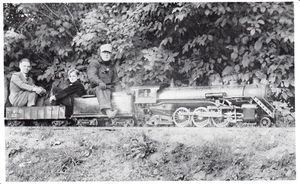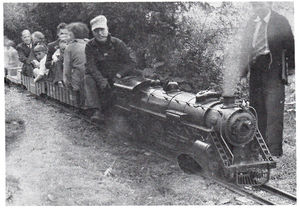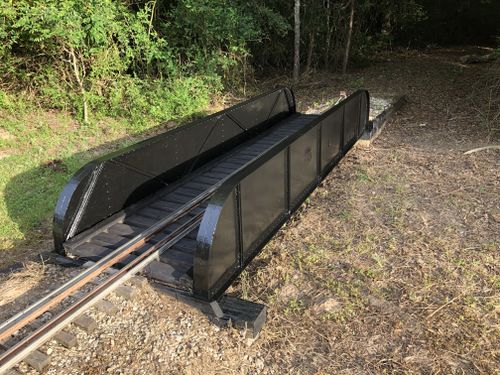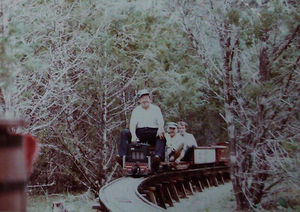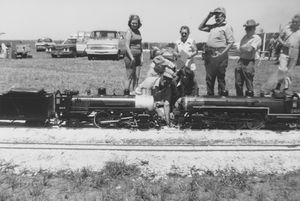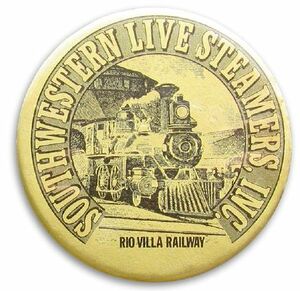Cliff Pettis
From Large-scale Model Railroading, p 6
- Cliff Pettis of Houston, Texas introduced a low cost line of car and locomotive parts, all in 1-1/2" scale. This line changed hands many times during the thirty or more years that it was available; originally starting as "Texas Railways" which became "Miller's Backyard Railroads", followed by "Bethlehem Pattern Supply", and finally, "Texas Railway Supply Inc". It is felt that this line started many enthusiasts in 1-1/2" scale modeling.
From "The History of the Southwestern Live Steamers"
- Prior to the formation of the club, scale railroaders abounded in Texas with tracks around their homes utilizing several different gauges. Some of these were Harold Timm of Dallas, Ces Beck of San Antonio, John Enders of Austin, Cliff Pettis of Houston, Vernon Greschel of Houston, Allen Guiberson and Lou Conklin of Dallas. Tracks were being planned by Henry Blossom of Wimberley and Roy Pickard of Priddy.
Visit to Whysall Light Railway
William C. Fitt wrote the following in Live Steam Magazine, March 1979:
- Back in July 1937, your Editor-In-Chief (William C. Fitt) was bitten by the Live Steam Bug while running Horace Shaw's 1-1/2 inch scale Pacific in Bloomfield Hills, Michigan, and never fully recovered.
- About a year later, Cliff Pettis, who is currently Vice President of the Southwestern Live Steamers, attended an Open House at Shaw's Whysall Light Railway and took the photos shown here, and was also infected by the smell of coal smoke and cylinder oil. That's Cliff's brother, Hugh Pettis, sniffing coal smoke in one photo and sitting in the riding car behind Horace Shaw in the other. Cliff went on to form Texas Railways in Houston, Texas, in 1947 and his patterns and designs were sold later to Robert Miller of Miller Backyard Railroads and then to Bethlehem Pattern and Model Shop in Pennsylvania. To complete the circuit, they went back to Terry McGrath of the defunct Texas Railway Supply Inc and, as a result, some of these castings show up on just about every 1-1/2 inch scale track in the country.
- Horace Shaw is still interested, although not active, in the Live Steam Hobby at his home in Bloomfield Hills...and many of us owe him a debt of gratitude for introducing us to the wonderful world of Live Steam!
Ed: The Live Steam article incorrectly stated that Hugh was the son of Cliff. Rose Pettis Fisher, Cliff's daughter, wrote 27 March 2020: "I’m forwarding your information to my uncle, Hugh Pettis, who was assumed to have been my father’s son in those older pictures. My uncle is now 93 years old, fifteen years younger than my father. When my uncle was eight years old (1935), my father took over the responsibility of raising him. Many people assumed he was my father’s son."
Horace Shaw at the throttle on the Whysall Light Railway during an open house in 1938, Bloomfield Hills, Michigan. The young man seated behind the tender is Hugh Pettis, brother of Cliff Pettis. Photo by Cliff Pettis.
Horace Shaw at the throttle, Hugh Pettis stands behind the front of the locomotive. Photo by Cliff Pettis.
Girder bridge at HALS
Jim Cash sent this photo to the HALS group after he pressure washed and painted this girder bridge.
Pete Greene commented:
- Looks like brand new. Brings back memories of when I used to run across that bridge when it was nearly new on Cliff Pettis' railroad located on the San Jacinto River back in the 1980's.
HO Scale
Rose Pettis Fisher send the following to Spence Gaskin of HALS, 27 March 2020:
- I’m forwarding your information to my uncle, Hugh Pettis, who was assumed to have been my father’s son in those older pictures. He, too, was infected with the “train bug,” and ended up devoting his time after retirement to developing an amazing, extravagant, intricate (HO scale?) model railroad of his own. It was his fictitious 19th century English Midlands railroad as seen a century later (ca. 1949-1950) when steam power still ruled. He named it the Upper Ouse Railway (UOR). He sent me a 33-minute DVD which his son had edited and showed the entire development of the display. It was a complete town, including church and cemetery, which grew with the presence of the railway. He put a lot of thought into establishing a town which was dependent on the existence of the railway system, including a maintenance barn for the engines. My uncle is now 93 years old, fifteen years younger than my father. When my uncle was eight years old (1935), my father took over the responsibility of raising him. Many people assumed he was my father’s son.
- When my uncle Hugh moved to live with my father in 1935, he was delighted to see that my father (Cliff) was constructing in meticulous detail an HO-scale model of a Baldwin Locomotive Prairie-class (2-6-2) steam engine. He was carefully measuring and scaling down its details from 10-foot-long blueprints he had gotten from the famous locomotive company. He was constructing the model from brass and tin stock, as he manually fabricated it with tools and soldering iron. His work was precise, accurately measured, and cut. He built an impressive HO-scale layout about 9’x9’ square. This was his “opus magnum” built to a very new and commercially-undeveloped market – “HO” at 1/87 stood for “half-0” the smallest popular model railroad scale of 1/45. Some prototypical freight car kits by Gordon Varney were coming into the market, but no locomotives were available then either as kits or off-the-shelf. My father was scratch-building one for himself (this Prairie 2-6-2) for his mountain and valley layout. My uncle has also described to me the clever arrangement of tracks and trains that came from my father’s creative imagination for his 9’x9’ display. My uncle said he has never seen anything like it in any model RR publication. This is the way he described it:
- “Imagine two circles of track about the same diameter, one laying atop the other and sharing a single common point of contact. The two loops or circles of track sharing a common connection can either (1) allow one train to transit one loop then shift to the other loop before returning – thus doubling the amount of trackage a single train can travel over, or (2) switching at the junction point can allow TWO separate trains each on either of the two loops to run simultaneously, meeting only at the junction point. The two loops were easily separated by altitude in scenery – one loop running atop a mountain (with a bridge or trestle crossing the lower loop in a valley below), the lower loop serving a scenic area in the center of the 9’x9’ layout with station and buildings.”
Gallery
Cliff Pettis routing the trestle at Henry Blossom's track at Wimberley, Texas. Ces Beck is the first passenger behind Cliff. Photo by Pete & Donna Green.
John Enders driving the Golden Spike on the Austin & Texas Central Railroad at Manor, Texas, 1974. Paul King kneels beside him. Also in the photo are Carolyn Enders Balkum, Ces Beck, Everett Adcock, Louise Adcock, Cliff Pettis, unknown, and Lee Balkum. Photo from Stephen Balkum collection.
